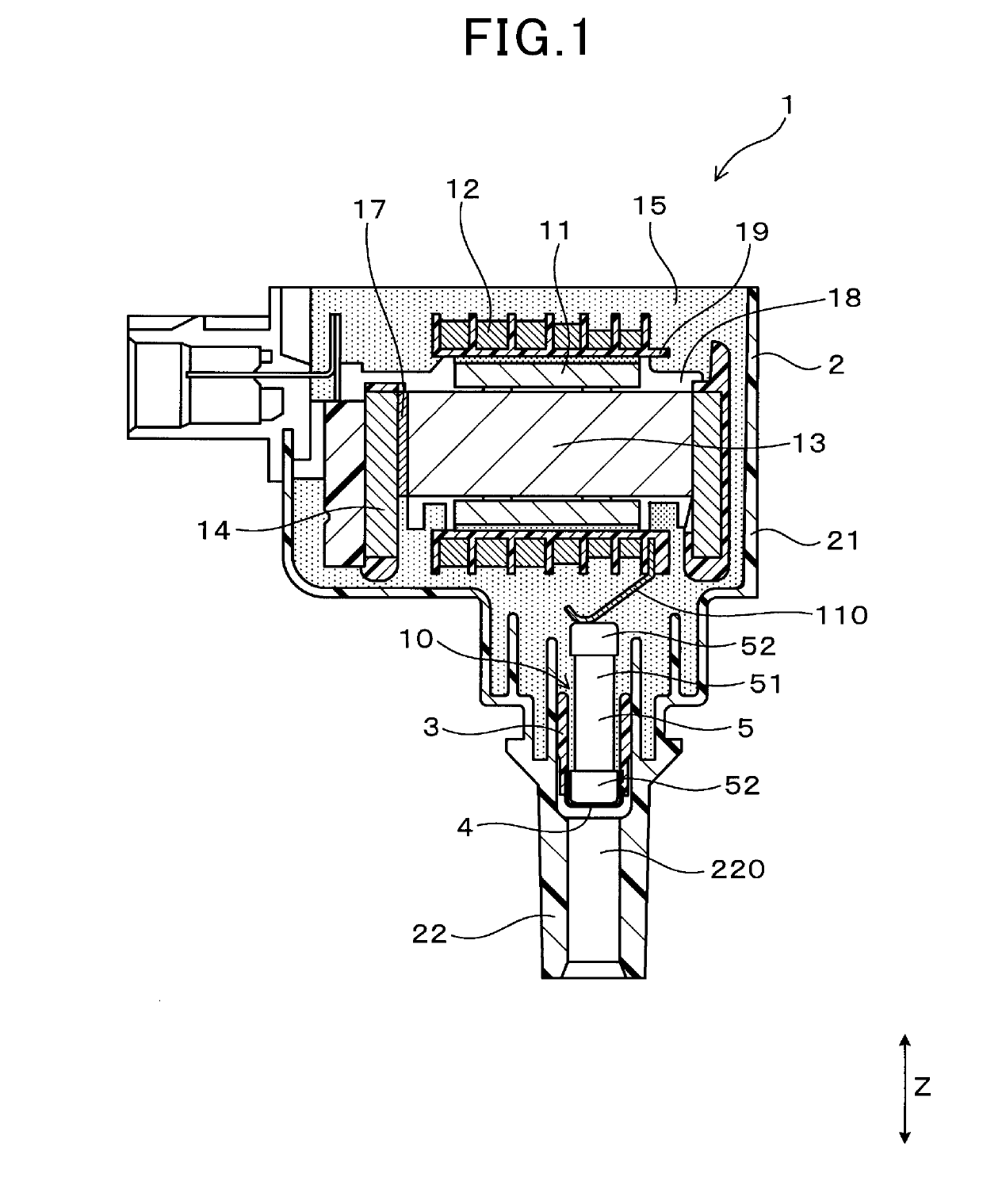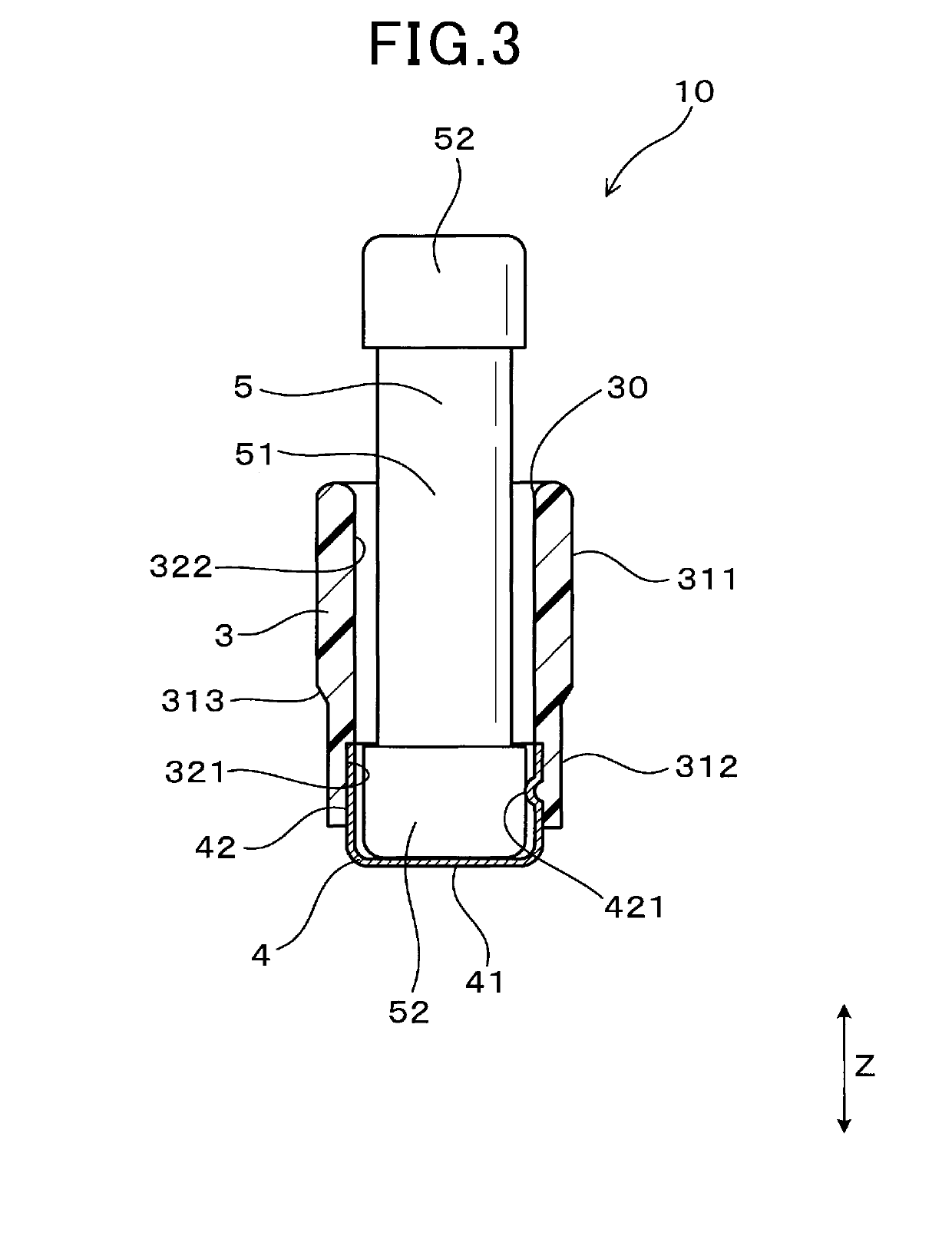Ignition coil for internal combustion engine
- Summary
- Abstract
- Description
- Claims
- Application Information
AI Technical Summary
Benefits of technology
Problems solved by technology
Method used
Image
Examples
first embodiment
[0046]The ignition coil 1 for internal combustion engines according to the first embodiment will be described below with reference to FIGS. 1 to 6.
[0047]The ignition coil 1, as clearly illustrated in FIG. 1, includes the primary coil 11, the secondary coil 12, the case 2, the closing member 10, and the filled resin 15. The primary coil 11 and the secondary coil 12 are magnetically coupled together. The case 2 includes the case body 21 in which the primary coil 11 and the secondary coil 12 are disposed and the hollow cylindrical high -voltage tower 22 protruding or extending downward from the case body 21. The closing member 10 is press-fit in the high-voltage tower 22 to close the inside of the high-voltage tower 22. The filled resin 15 is disposed in the case body 21 and hermetically seal the primary coil 11 and the secondary coil 12.
[0048]The closing member 10 includes the resinous cylinder 3, the high-voltage terminal 4, and the resistor 5. The resinous cylinder 3 is made from re...
second embodiment
[0080]FIG. 7 illustrates the closing member 10 according to the second embodiment.
[0081]The high-voltage terminal 4 has the holes 43 formed in the periphery thereof. The holes 43 extend through a thickness of the high-voltage terminal 4 in the radial direction of the high-voltage terminal 4 and lie in a region expanding in the vertical direction Z where the high-voltage terminal 4 and the resinous cylinder 3 are firmly attached to each other. In other words, the holes 43 face a contact of area between the high-voltage terminal 4 and the resinous cylinder 3 in the radial direction of the high-voltage terminal 4. The resinous cylinder 3 is partially disposed in the holes 43.
[0082]Specifically, the holes 43 are, as clearly illustrated in FIG. 8, arranged at three places in the inner periphery of the high-voltage terminal 4 and at equal intervals away from each other in the circumferential direction of the high-voltage terminal 4. All the holes 43 are arranged away from the inner protru...
third embodiment
[0088]FIG. 10 illustrates the closing member 10 according to the third embodiment.
[0089]In a region extending in the vertical direction Z where the high-voltage terminal 4 and the resinous cylinder 3 are firmly attached to each other, the high-voltage terminal 4 has formed on the outer periphery thereof the outer protrusions 423 which bulge outward into the inner periphery of the resinous cylinder 3 in the radial direction thereof.
[0090]The outer protrusions 423 are formed using a press. The outer protrusions 423 are of a semi-spherical shape in cross section. The resinous cylinder 3 has formed in the large-diameter inner surface 321 the recesses 321a firmly attached to the outer protrusions 423. The locations of the outer protrusions 423 of the high-voltage terminal 4 are the same as those of the holes 43 in the second embodiment illustrated in FIGS. 7 to 9.
[0091]Other arrangements are identical with those in the first embodiment.
[0092]The third embodiment offers substantially the ...
PUM
 Login to View More
Login to View More Abstract
Description
Claims
Application Information
 Login to View More
Login to View More - R&D
- Intellectual Property
- Life Sciences
- Materials
- Tech Scout
- Unparalleled Data Quality
- Higher Quality Content
- 60% Fewer Hallucinations
Browse by: Latest US Patents, China's latest patents, Technical Efficacy Thesaurus, Application Domain, Technology Topic, Popular Technical Reports.
© 2025 PatSnap. All rights reserved.Legal|Privacy policy|Modern Slavery Act Transparency Statement|Sitemap|About US| Contact US: help@patsnap.com



